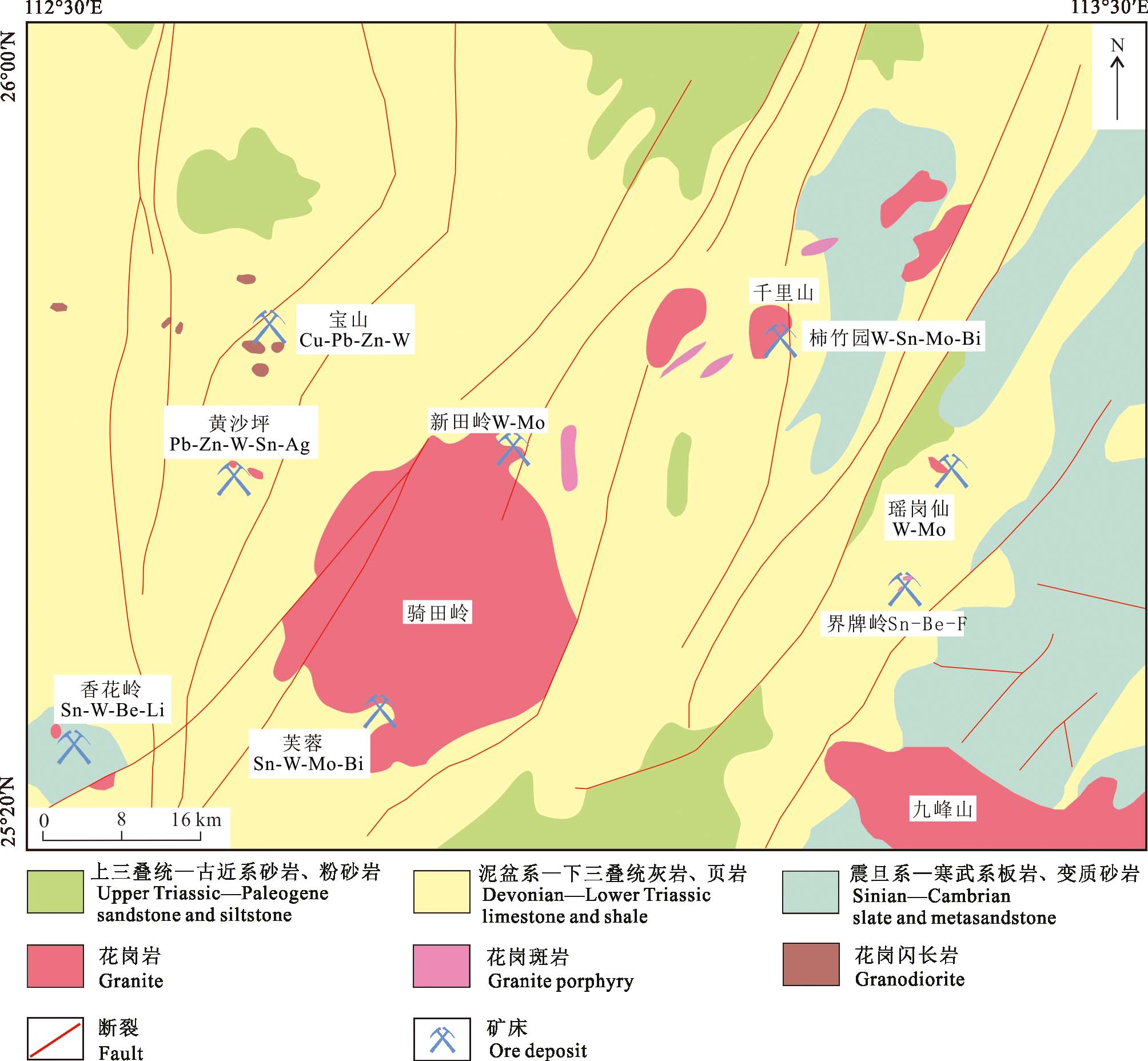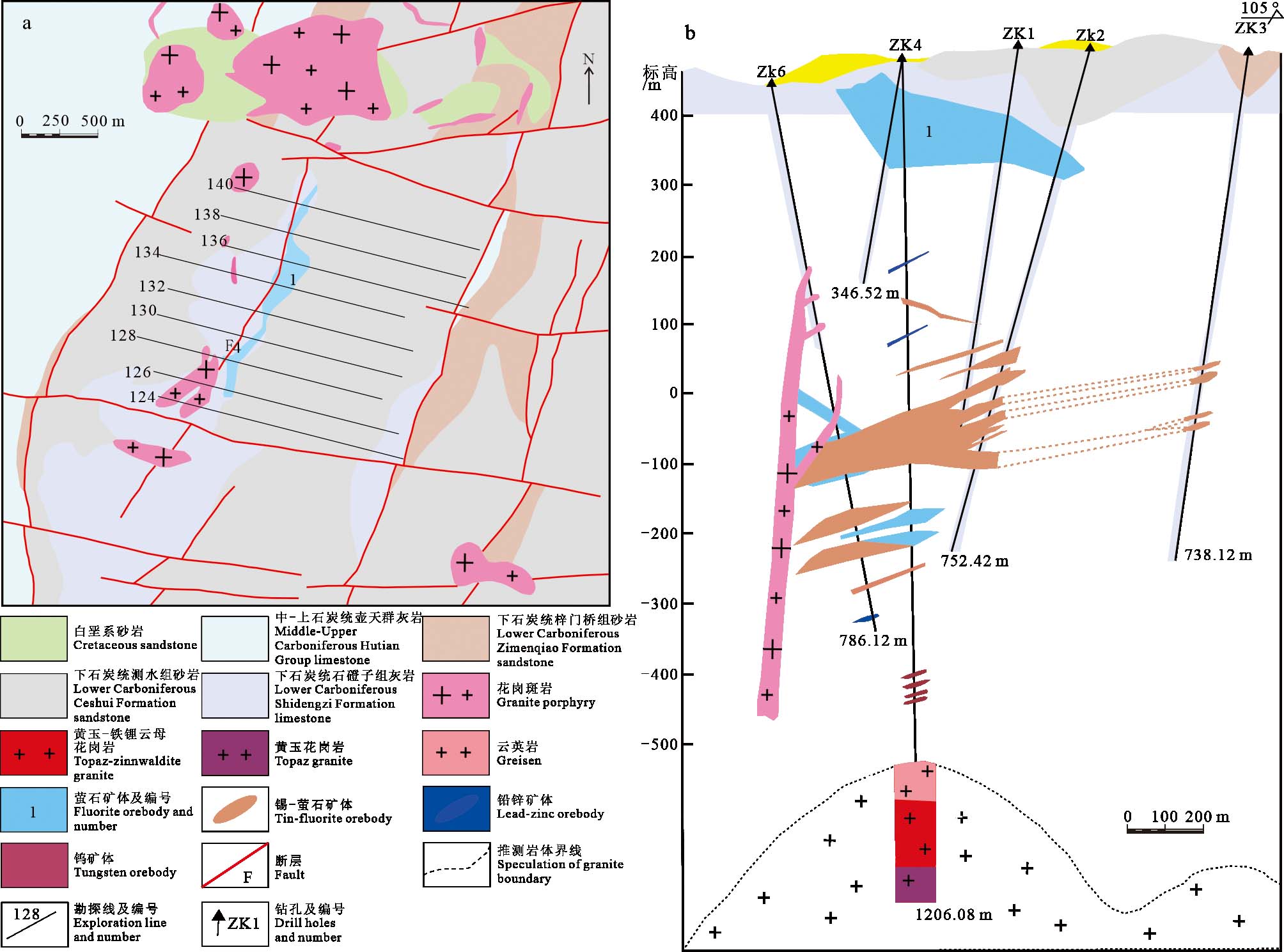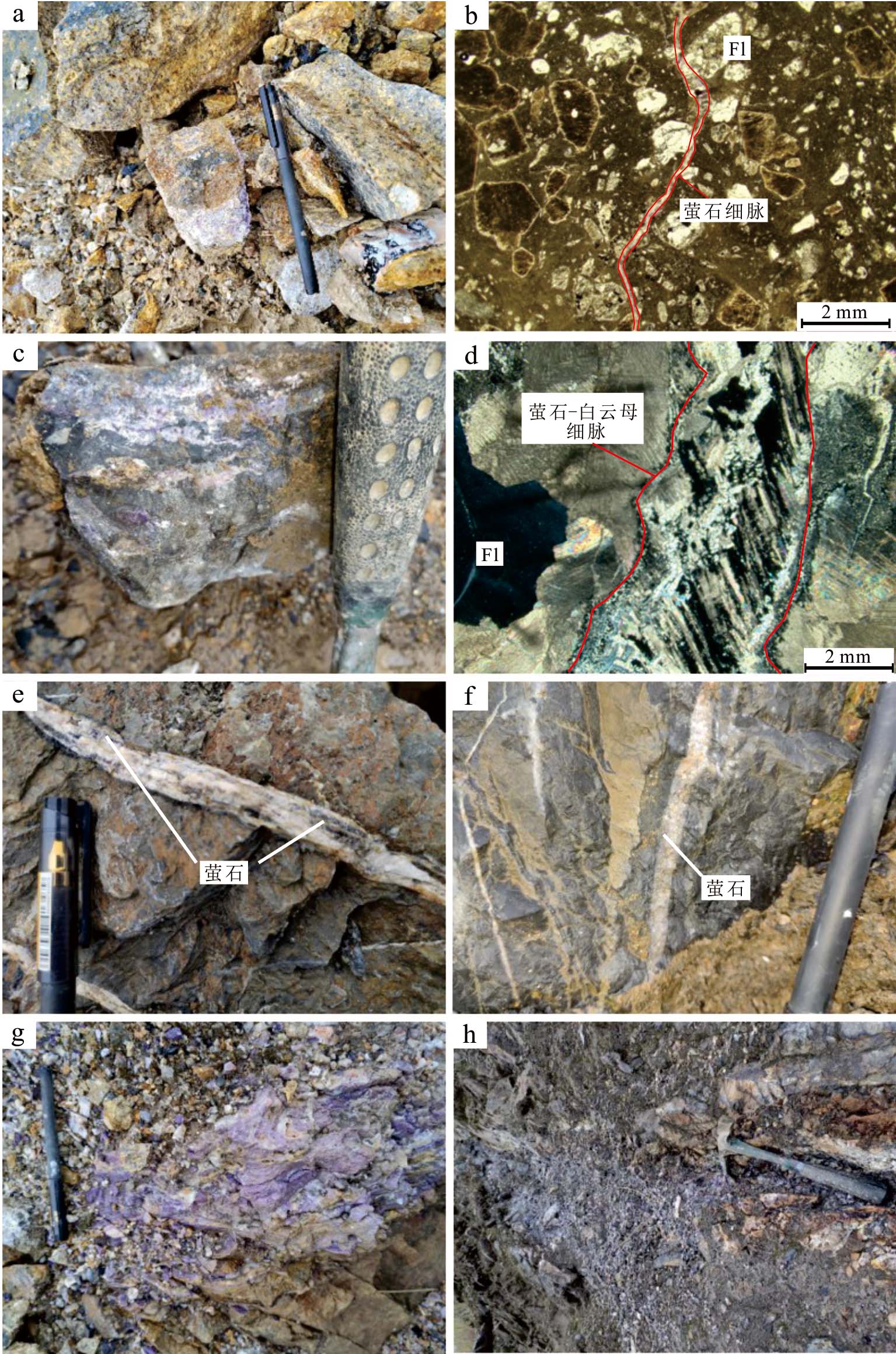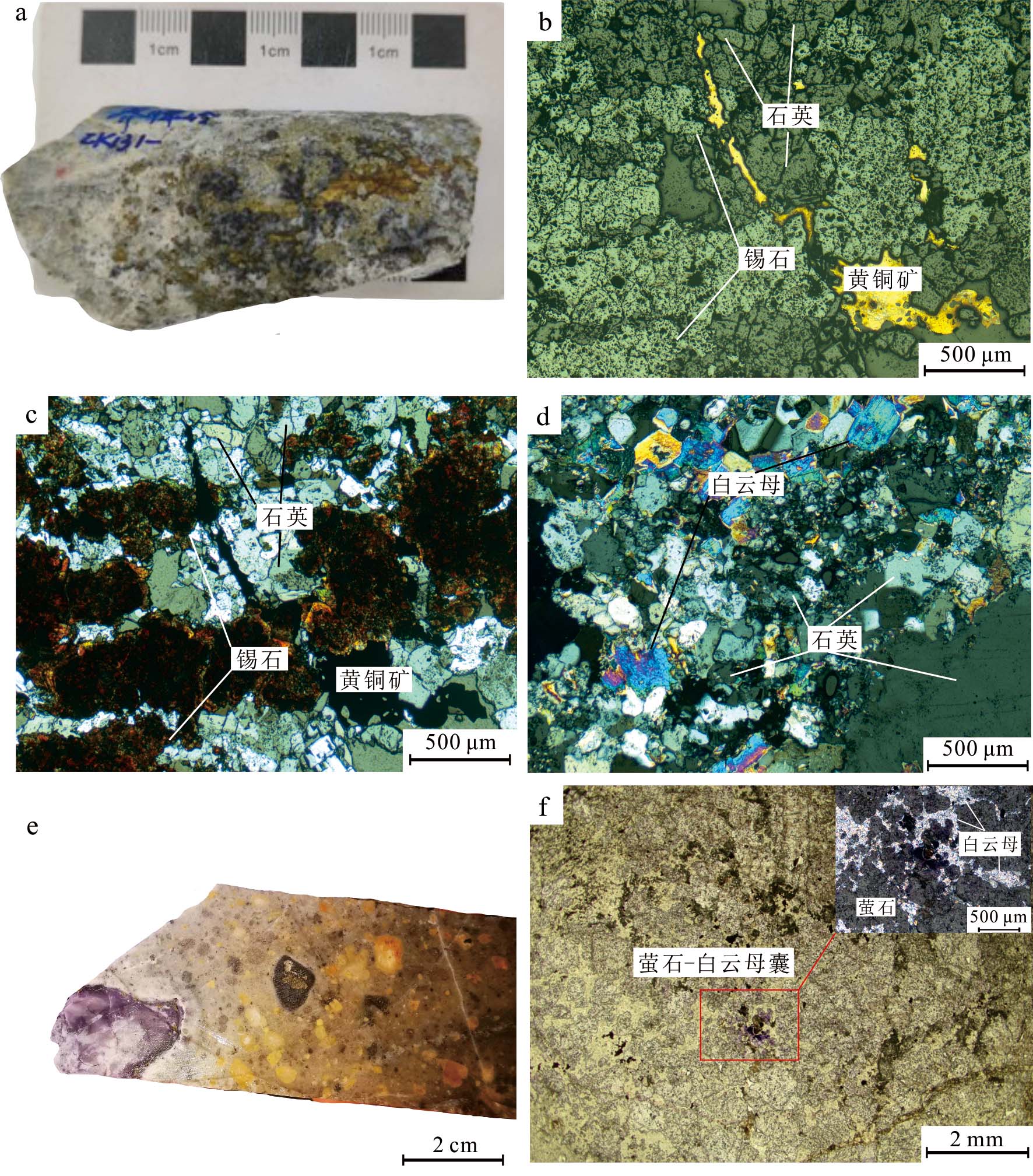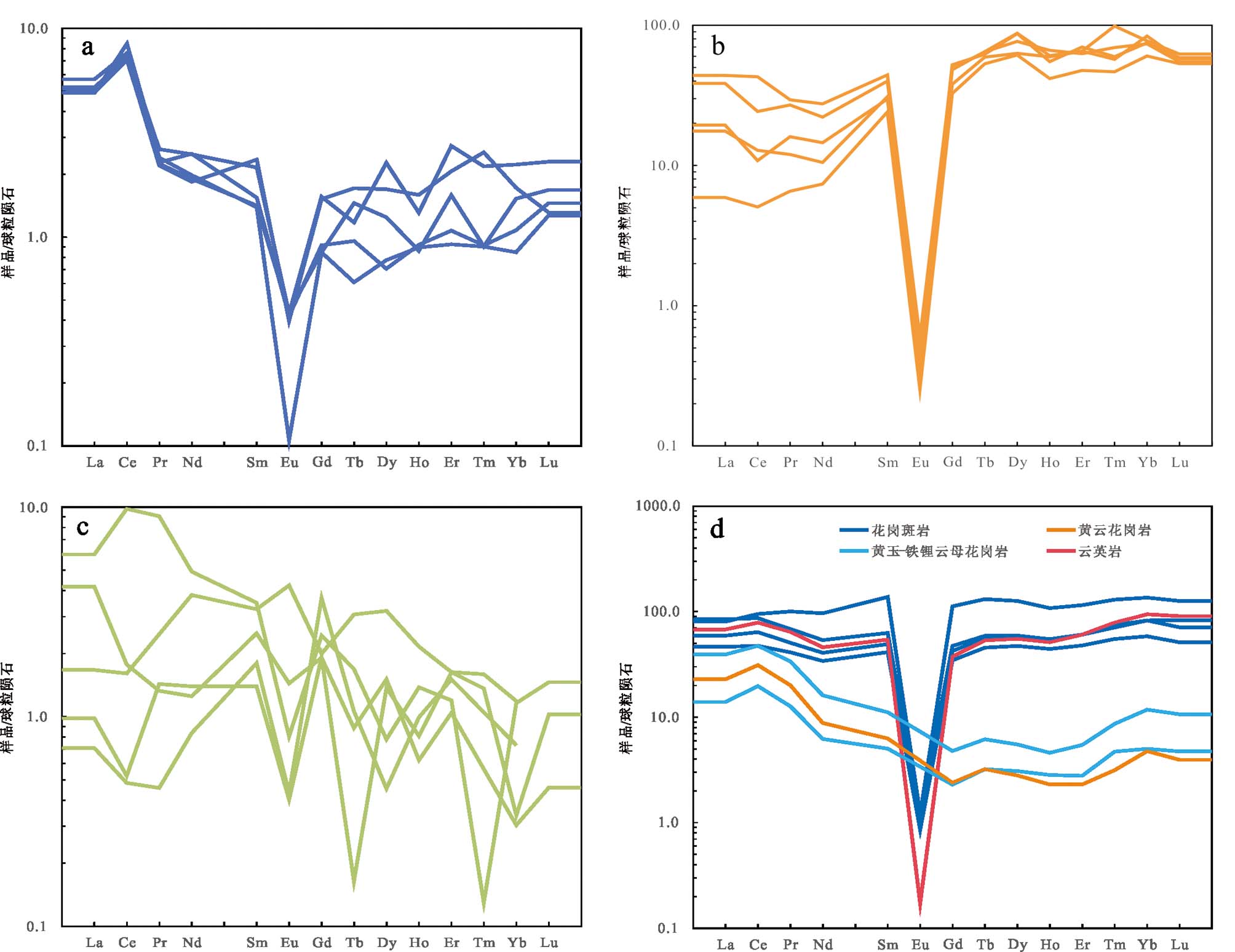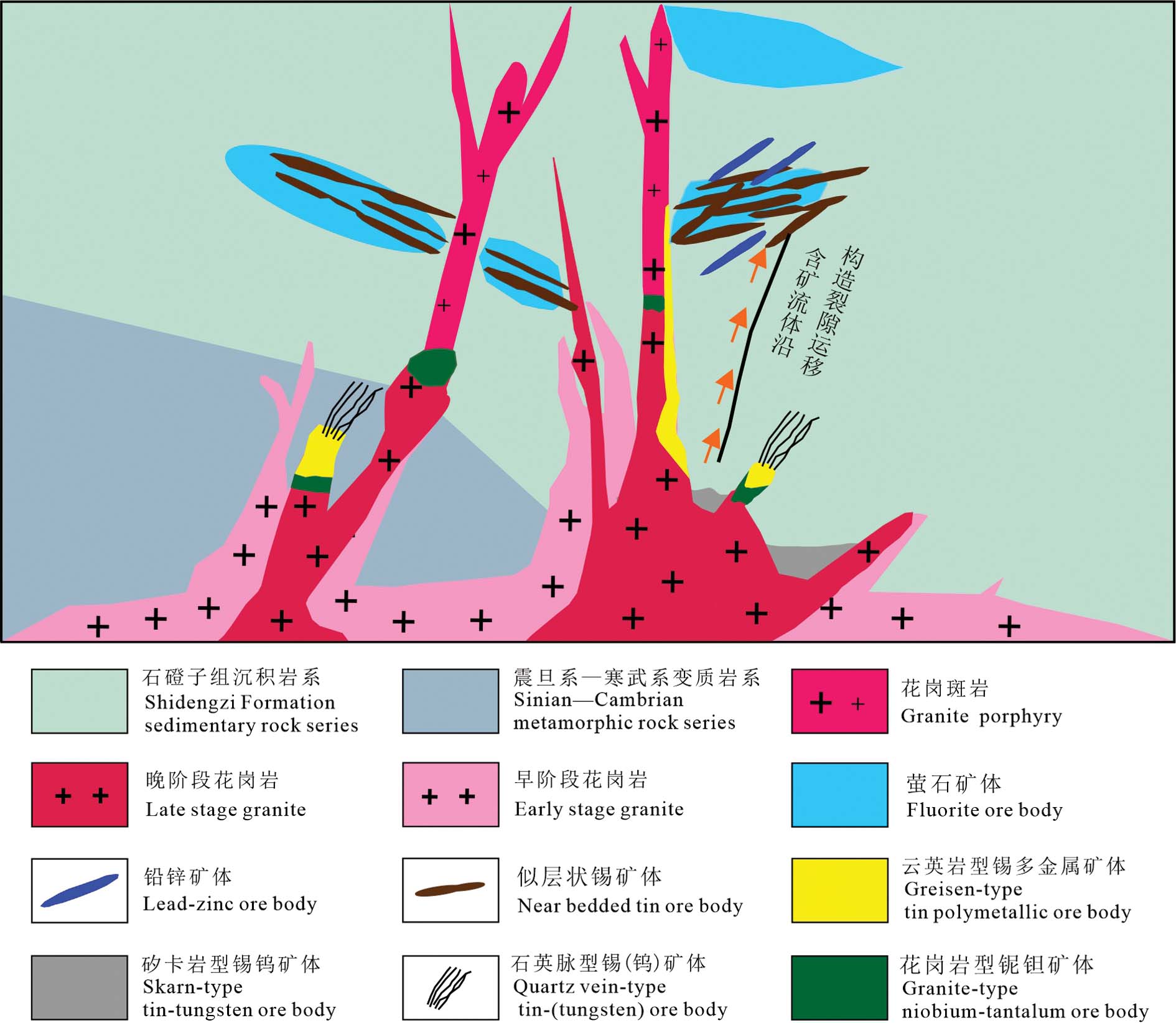-
界牌岭位于南岭成矿带中段与钦杭结合带的交会部位,是湘南地区(图1)近年来新发现的大型锡萤石矿床(图2a),锡(资源量89 838 t)和萤石(矿物量1461.7万t)均达大型规模,共伴生锂、铍、铌、钽、锌等重要资源(侯占德等,2023)。界牌岭矿床以浅部脉状萤石矿与深部层状锡多金属矿分带共生为特色。前人学者对界牌岭矿床地质、成矿流体特征和成岩成矿年代开展了研究(刘悟辉等,2006;雷泽恒等,2009),锆石U-Pb定年限定了浅部花岗斑岩的侵位时代为88~91 Ma(Yuan et al.,2015;沈宏飞,2022),云母Ar-Ar法及锡石U-Pb法限定了锡石成矿年龄为86~92 Ma(Xie et al.,2016;刘飚等,2021),推断花岗质岩浆作用与锡石和萤石矿化具有密切成因联系(许若潮等,2022)。但关于锡石和萤石的成矿环境、成矿流体的演化关系尚缺乏系统研究和微观约束,制约了深部勘查工作。本文在详细的矿床地质工作基础上,对界牌岭不同矿化段的萤石和锡石进行了矿物学研究,结合微区原位微量元素分析,探讨了成矿流体的性质、来源及Sn-F矿化关系,构建了界牌岭矿床勘查模型,并提出了该类型矿床的找矿标识,为南岭地区锡多金属矿产勘查提供了新的理论依据。
1区域地质湘南地区广泛分布晚古生代沉积地层,其中,泥盆纪—石炭纪碳酸盐岩是区内钨锡多金属矿床最重要的赋矿层。区内岩体和地层展布明显受NE向、NNE向和EW向构造控制。其中,NE向的茶陵-临武断裂、衡阳-祁阳-永州断裂及攸县-耒阳断裂,控制了区内主要花岗岩体及相关的锡钨多金属矿床空间分布。区内出露的岩浆岩主要为中生代黑云母或二云母花岗岩,少量花岗闪长岩和花岗斑岩。区内矿产以钨、锡、铅、锌、银、萤石为主,矿化类型有花岗岩型、云英岩型、矽卡岩型、锡石-硫化物型和石英脉型,矿体多产于岩体内外接触带及构造断裂带处(图1)。
界牌岭矿区出露地层主要为下石炭统石磴子组、测水组、梓门桥组和中上石炭统壶天群,并有白垩系零星分布。石磴子组出露于矿区背斜核部,北北东向展布,主要由灰岩夹同生角砾状白云质灰岩、泥质灰岩、生物碎屑灰岩组成。测水组在该区分布最为广泛,为厚约120 m的灰白色、灰黑色中层至厚层状细粒石英砂岩、石英粉砂岩、砂质页岩、含砾石英砂岩、砂砾岩、碳质页岩及劣质煤层,并含黄铁矿及菱铁矿结核。梓门桥组为浅海相碳酸盐岩沉积,下段为厚约20 m薄-中厚层状深灰色含生物碎屑灰岩,常见燧石结核;上段为厚约40 m中厚-巨厚层状灰黑色细粒白云岩夹角砾状白云岩。壶天群分布在矿区外围,主要为厚420~450 m巨厚层状灰白色、肉红色白云岩,顶部为灰白色白云岩夹白云质灰岩。
图1湘南地区地质简图及锡钨矿床分布(修改自Yuan et al.,2015)
Fig. 1 Simplified geological map of southern Hunan Province and distribution of Sn-W deposits (modified after Yuan et al.,2015)
界牌岭锡萤石矿体赋存于界牌岭背斜的核部,为区域性北东向关峪复向斜的二级背斜。背斜中部为石磴子组灰岩,东、西翼为测水组砂岩。背斜核部的脆性轴向断裂是矿液的运移和扩散的通道,为深部锡矿体形成有利容矿空间。区内北北东向、南北向和北西向断裂构造发育,其中,北北东向断裂是界牌岭主要控岩控矿构造。
2矿床地质2.1岩体地质界牌岭矿区沿F4断裂及背斜轴部出露花岗斑岩7处,呈岩墙、岩脉和岩株状产出(图2a),岩浆岩在地表分布并不连续,但钻探信息显示其深部岩体增大可能连为一体,岩体走向与主构造线方向一致。花岗斑岩呈浅灰色-灰白色,斑状结构,块状构造,斑晶以石英、钾长石为主,次为斜长石,斑晶含量约30%~55%。基质主要为石英、长石、白云母等,含量约45%~70%,本次工作发现了花岗斑岩中铌钽和稀土矿化(图3a~f)。钻孔揭露黄玉铁锂云母花岗岩呈白色,主要成分为钾长石、钠长石及少量石英(Xie et al., 2016)。
根据矿区岩浆岩产状、穿插关系及岩相学特征,界牌岭岩浆活动分为4个阶段:①伴有强烈隐爆作用的巨斑状花岗斑岩;②伴有部分隐爆作用的中粒花岗斑岩;③富含斜长石的中细粒花岗斑岩(田野等,2016);④深部Nb-Ta-W-Sn矿化黄玉铁锂云母花岗岩。岩石地球化学研究显示,界牌岭花岗斑岩富含W、Sn、Be、Cu、Pb、Zn等成矿元素及Li、F等挥发组分,稀土元素总量明显高于南岭花岗岩平均值(陈伟栋,1989;侯建强,1999;王艳丽等,2014;何占珍等, 2016;林晓青等,2020)。
2.2矿体地质界牌岭矿床已探明各类矿体77个,由浅部层间破碎带内(含铍)萤石矿体与深部蚀变带内锡多金属矿体组成。其中,1号矿体是目前最大的含铍萤石矿体(图2a、b),矿体走向长700 m,平均厚16.5 m,宽250 m,平均Sn品位0.83%。矿石矿物有锡石、金绿宝石、黄铁矿、萤石等,少量方铅矿、闪锌矿。脉石矿物主要为石英、白云母、黄玉和方解石。
浅部萤石矿体据其产状可划分为4种类型,其中,①蚀变斑岩型矿体:萤石以斑晶的形式产出,粗粒球状,靠近接触带,萤石粒度变细,含量升高,亦可见萤石细脉;②细脉-条带型矿体:萤石呈微细-细粒集合体形式产出,常与云母、细粒方解石共生形成细脉或条带;③方解石-石英-萤石脉:萤石与石英、方解石共生常呈脉状产出在(蚀变)灰岩中,倾角较小的脉体较倾角较大的脉体萤石含量偏高;④构造破碎带型:萤石呈似层状或角砾状充填在裂隙或构造破碎带中(图4a~h)。深部锡多金属矿体主要隐伏于124~142线间的50~-150 m标高间(图2a、b)。全区的锡多金属矿体主要呈似层状产于花岗斑岩东侧外接触带的黄玉、云母和萤石化蚀变交代岩中,矿体走向北北东,倾向北西西,倾角25°~55°。已控制走向长700 m,倾斜延伸300 m;矿体厚度4.32~107.9 m,平均厚度为22.35 m;Sn、Cu、CaF2平均品位分别为0.81%、0.53%、27.39%。另外,还有Bi2O3(0.017%),Ag(8.45 g/t)等伴生矿产(肖林等,2023)。锡多金属矿体可分为云英岩型锡矿体(图5a)、萤石-云母-(黄玉)-锡铅锌铜脉型矿体、黄玉-云母-萤石型锡铜矿体、石英脉型锡钨铜矿体、云母-石英-(黄玉)脉型锡锂矿体以及云母脉型锂矿体。云英岩型锡矿体主要赋存在花岗斑岩与围岩的接触带处,锡石以半自形-自形粒状晶体散布于石英-云母等共生矿物之间,粒径一般为0.02~1.00 mm(图5b、c)。锡多金属矿体矿石矿物主要有锡石、黄铜矿、闪锌矿,次为方铅矿、黑钨矿、黄铁矿、毒砂、褐铁矿、菱锰矿等。锡多金属矿床具有分带特征,即以岩体为中心向外侧呈现出Sn-W、Sn、Sn-Cu、Sn-Zn、Pb-Zn、Be的矿化分带,及由深到浅贯穿性的Li-F矿化,与矿区近东西向剖面显示出面状分布的Li的原生晕相吻合(田野等,2016)。
图2湘南界牌岭矿床地质简图(a)和132勘探线地质剖面图(b)
Fig. 2 Simplified geological map of the Jiepailing deposit, southern Hunan Province (a) and Geological cross-section at No.132exploration line through the Jiepailing deposit (b)
图3界牌岭矿床(蚀变)花岗斑岩手标本、镜下特征及稀有稀土矿物背散射图像a.花岗斑岩;b.正交偏光下花岗斑岩;c.萤石化花岗斑岩;d.正交偏光下萤石斑晶;e.氟碳铈矿背散射图像;f.铌铁矿背散射图像
Fig. 3 Hand specimens of (altered) granite porphyry, mineral assemblages under microscope and BSE images of rare earth minerals in the Jiepailing deposit a. Granite porphyry; b. Granite porphyry (under cross-polarized light); c. Fluorite granite porphyry; d. Fluorite phenocryst (under cross-polarized light); e. BSE image of bastnaesite; f. BSE image of columbite
图4界牌岭矿床浅部不同类型萤石矿体野外露头及镜下特征 a.蚀变斑岩型矿体;b.单偏光下花岗斑岩中萤石细脉;c.萤石化灰岩;d.正交偏光下萤石-白云母脉;e.近水平方解石-石英-9萤石脉;f.近直立方解石-石英-萤石脉;g.破碎带内萤石矿体;h.断裂内萤石矿体
Fig. 4 Outcrop of different types of fluorite orebodies and mineral assemblages under microscope in shallow zone from theJiepailing deposita. Altered-porphyry type orebody; b. Fluorite vein in granite porphyry (under plane-polarized light); c. Fluoritization limestone; d. Fluorite-muscovite veins (under cross-polarized light); e. Near-horizontal calcite-quartz-fluorite veins; f. Near-vertical calcite-quartz-fluorite veins; g. Fluorite orebody in the fracture zone; h. Fluorite orebody within the fault
图5界牌岭矿床深部锡石和萤石手标本及镜下特征 a.云英岩型锡矿石;b.反射光下浸染状锡石与黄铜矿、石英共生;c.正交偏光下浸染状锡石与黄铜矿、石英共生;d.正交偏光下云英岩化;e.花岗斑岩中萤石-白云母囊;f.正交偏光下萤石与白云母共生
Fig. 5 Hand specimens of cassiterite and fluorite ores and mineral assemblages under microscope in depth from the Jiepailing deposit a. Greisen-type tin ore; b. Disseminated cassiterite is associated with chalcopyrite and quartz (under reflected light); c. Disseminated cassiterite is associated with chalcopyrite and quartz (under cross-polarized light); d. Greisenization (under cross-polarized light); e. Fluorite-muscovite sac in granite porphyry; f. Fluorite is associated with muscovite (under cross-polarized light)
界牌岭矿床蚀变具有明显的垂直分带特征:从地表到深部,发育大规模贯穿性萤石、云母矿化,依次发育与锂铍矿化相关的萤石化、云母化,与铅锌矿化相关的绿泥石-云母化,与锡铜矿化相关的萤石绢英岩化、黄玉石英岩化,与锡钨矿化相关的云英岩化(图5d)、萤石绢英岩化等。
3样品及测试方法用于萤石LA-ICP-MC微量元素分析的样品JPL-1(阶段Ⅰ深部含萤石囊的花岗斑岩)、JPL-3-1(阶段Ⅱ含萤石斑晶的蚀变花岗斑岩)和JPL-1-3(阶段Ⅲ萤石化灰岩)样品湖南界牌岭矿床露天采坑450 m标高平台及岩芯库处。其中,样品JPL-1采集于ZK5/128孔深475 m处,样品JPL-3-1与样品JPL-1-3采集于450 m标高平台花岗斑岩与围岩接触带处;用于锡石电子探针及LA-ICP-MC微量元素分析的样品JPL采集于钻孔Zk1/131孔深495 m处,为含锡石云英岩矿石(图5a)。
电子探针分析和背散射电子图像(BSE)拍摄在中国地质科学院矿产资源研究所电子探针实验室进行,使用仪器为JXA-8230电子探针仪,设置加速电压为15 kV,电流为15 nA,束斑直径为1μm,仪器的检测限制为0.01%~0.05%。测试元素包括SnO2、WO3、Nb2O5、Nb2O5等,采用ZAF校正法。
锡石、萤石原位微量元素分析在国家地质实验测试中心完成,使用仪器为Agilent 8900串联四极杆ICP-MS(ICP-MS/MS),配合激光剥蚀系统为NWR193。实验采用He作为剥蚀物质的载气,激光束斑直径为40μm、剥蚀时间为40 s、脉冲频率6 Hz、能量3 J,微量元素处理过程选用610作为外标。
4分析结果4.1锡石主微量元素特征锡石主量元素含量分析结果见附表1。界牌岭矿床锡石颗粒的电子探针分析数据显示,其变化范围一般很窄,w(SnO2)>96.76%、w(FeO)(0.43%~1.96%)、w(WO3)(0.07%~0.64%)、w(Ta2O5)≈0.01%。
表1界牌岭矿床锡石电子探针分析结果(w(B)/%)
Table 1 EPMA elemental concentrations of cassiterite from the Jiepailing deposit(w(B)/%)
组分
JPL-1
JPL-2
JPL-3
JPL-4
JPL-5
JPL-6
Al2O3
0.05
0.06
0.05
0.04
0.05
0.04
SiO2
0.54
0.28
0.30
0.31
0.35
0.22
TiO2
0.05
0.05
0.27
0.04
0.05
0.04
MnO
0.01
0.04
-
-
0.01
0.04
FeO
0.43
1.50
1.62
1.17
1.96
1.15
SnO2
98.63
97.12
97.46
98.00
96.76
97.67
Nb2O5
-
-
-
-
-
-
Ta2O5
0.01
0.01
0.01
0.01
0.01
0.01
WO3
0.13
0.64
0.07
0.18
0.46
0.56
总和
99.85
99.70
99.78
99.75
99.65
99.73
注:“-”代表低于检测限。
锡石微量元素含量分析结果见附表2和图6a~f。由此可知,界牌岭矿床锡石具有较宽的微量元素谱系,主要以w(W)(553.50×10-6~5065.16×10-6)和w(Ti)(234.60×10-6~1626.90×10-6)为主。高场强元素(HFSE)的浓度相对较高,包括w(Zr)(212.56×10-6~510.60×10-6)、w(Hf)(74.60×10-6~220.80×10-6)、w(Nb)(42.70×10-6~141.30×10-6)、w(Ta)(1.90×10-6~17.00×10-6),同时,具有较高的w(Fe)(3313.20×10-6~15 248.90×10-6),较低的w(Mn)(21.20×10-6~285.70×10-6)。锡石中的Sc与V、Zr与Hf、Nb与Ta等都表现为良好的正相关性(图8a~f)。
4.2萤石微量元素特征萤石中微量元素含量分析结果见附表3和图7、图8。由阶段Ⅰ至阶段Ⅱ萤石样品,萤石内w(Li)、w(Be)元素逐渐升高(6.74×10-6~60.18×10-6;0.19×10-6~10.16×10-6);萤石内w(Sn)逐渐降低(0.50×10-6~1705.82×10-6)。
阶段Ⅰ与阶段Ⅲ萤石样品的ΣREE含量较低,为2.54×10-6~12.43×10-6,阶段Ⅱ萤石样品ΣREE含量较高,为59.55×10-6~120.80×10-6。Ⅲ阶段萤石样品LREE/HREE比值依次为3.96~8.85、0.26~0.96、0.89~8.74;(La/Yb)N比值分别为2.56~6.06、0.10~0.60、1.14~13.74。阶段Ⅰ与阶段Ⅱ萤石样品均表现强烈Eu负异常(0.01~0.40),但前者表现为LREE相对富集(平均值7.33×10-6)的特征,后者表现为HREE(平均值59.60×10-6)相对富集的特征。阶段Ⅰ萤石样品表现为强烈的Ce正异常(1.96~2.46),阶段Ⅱ与阶段Ⅲ萤石样品均表现出微弱的Ce负异常(0.61~0.88、0.44~0.85)。
5讨论5.1萤石地球化学对成矿环境的指示界牌岭3个阶段萤石Tb/Ca和Tb/La值分别介于1.6×10-7~8.8×10-7、0.03~1.41,指示其均为热液成因(图6a)。萤石中的Y与Ho元素具有相似的离子半径与电位,Y/Ho比值可以指示成矿流体来源(Bau et al., 1995),Y/Ho值分别为33.5~52.9、16.4~22.9、35.1~65.8,显示界牌岭3个阶段的萤石来自同源的岩浆热液(图6b)。
表2界牌岭矿床锡石LA-ICP-MC微量元素分析结果(w(B)/10-6)
Table 2 LA-ICP-MC trace element concentrations of cassiterite from the Jiepailing deposit(w(B)/10-6)
组分
JPL-1
JPL-2
JPL-3
JPL-4
JPL-5
JPL-6
组分
JPL-1
JPL-2
JPL-3
JPL-4
JPL-5
JPL-6
Li
2.38
0.91
0.71
1.09
0.57
0.88
La
0.44
0.47
1.09
0.41
0.46
0.44
Be
28.38
117.02
65.87
33.97
74.11
116.24
Ce
0.13
0.24
2.14
0.14
0.26
0.20
B
88.54
69.59
74.33
79.16
75.21
72.75
Pr
0.40
0.41
0.58
0.37
0.38
0.39
Sc
57.78
279.26
93.27
235.01
327.74
166.09
Nd
0.03
0.06
0.45
0.03
0.06
0.05
V
11.20
5.53
53.51
9.48
10.52
12.04
Sm
0.01
0.03
0.10
0.02
0.04
0.03
Cr
3.79
0.30
0.48
0.44
0.46
11.08
Eu
-
-
-
-
-
-
Co
13.49
13.16
13.15
13.40
13.05
13.18
Gd
0.37
0.33
0.37
0.35
0.32
0.34
Ni
92.28
92.44
90.12
91.02
91.06
90.64
Tb
0.06
0.07
0.06
0.06
0.06
0.06
Cu
4.72
27.54
0.19
1.89
5.34
2.98
Dy
0.03
0.05
0.01
0.01
0.03
0.02
Zn
13.36
65.44
7.11
17.88
34.49
15.92
Ho
0.01
0.01
-
-
-
-
Ga
21.30
90.36
43.25
78.58
108.18
62.43
Er
0.03
0.04
-
0.01
0.02
0.01
As
0.93
6.00
1.40
2.74
7.49
4.24
Tm
0.01
0.01
-
-
0.01
-
Rb
2.37
0.84
0.41
0.73
0.49
1.01
Yb
0.07
0.17
0.02
0.06
0.14
0.07
Sr
0.06
0.27
0.06
0.13
0.32
0.19
Lu
0.01
0.05
0.01
0.02
0.04
0.02
Y
0.08
0.11
0.05
0.06
0.09
0.06
Hf
98.42
183.46
74.56
163.40
220.75
183.83
Zr
212.55
432.40
380.03
403.85
510.58
400.94
Ta
17.03
9.21
7.70
5.42
1.88
7.95
Nb
114.92
141.28
42.73
111.36
67.72
133.73
W
996.43
5065.16
553.50
1435.69
3667.08
4455.73
Mo
0.04
0.13
0.05
0.08
0.14
0.09
Au
0.05
0.08
0.04
0.06
0.08
0.07
Ag
0.06
0.12
0.05
0.05
0.07
0.05
Pb
1.71
6.06
0.81
2.02
4.70
2.33
Sb
61.14
64.26
155.83
52.89
108.15
87.60
Bi
0.06
0.54
0.10
0.17
0.47
0.19
Cs
1.35
1.35
1.29
1.46
1.24
1.60
Th
2.32
2.59
0.67
0.65
1.88
0.96
Ba
22.53
22.38
21.74
22.14
21.78
22.33
U
64.53
258.49
70.98
144.10
303.48
163.15
注:“-”代表低于检测限。
萤石中Ce和Eu的地球化学特征明显受成矿流体的pH值和Eh值、流体组成及温压环境影响,可指示成矿流体的氧化还原条件和温度变化(Castorina et al.,2020; Wang et al.,2021)。界牌岭矿床阶段Ⅰ萤石表现为明显的正Ce异常,阶段Ⅱ和阶段Ⅲ的萤石为弱负Ce异常,指示初始成矿热液流体的氧逸度较低,Ce3+不会氧化为Ce4+,而导致流体中富集Ce。而随着成矿流体运移,氧逸度升高,Ce3+易被氧化为Ce4+,而Ce4+溶解度很小,易被氢氧化物吸附而脱离溶液体系(彭建堂等,2002),使流体亏损Ce从而导致从该流体中沉淀出来的萤石显示负Ce异常。阶段Ⅰ和阶段Ⅱ萤石均表现为明显的负Eu异常,表明流体体系中可能存在着Eu2+。Eu2+离子半径较大,不易与其他REE3+共沉淀,从而限制其替代萤石中的Ca2+,Eu2+的存在也指示萤石形成于低氧逸度环境,与Ce的正异常相对应。阶段Ⅲ萤石显示,Ce与Eu的正负异常均有出现,指示该阶段流体中Ce3+与Ce4+、Eu2+与Eu3+共存,在萤石沉淀的温度条件(130~200℃),氧逸度相当于磁铁矿-赤铁矿或硫化物-硫酸盐的氧化-还原平衡状态,Eu2+与Eu3+共存(Sverjensky,1984)。界牌岭矿床成矿流体主体为花岗质岩浆热液,氧逸度较低,随着流体向浅部运移,可能与大气降水等浅部流体混合,氧逸度升高。
萤石在热液体系中的沉淀机制主要为:①成矿流体温度和压力条件变化;②流体混合作用;③成矿流体与围岩发生水岩反应(Richardson et al.,1979)。热液体系中REE-F络合物的稳定性从La至Lu逐渐增加(Wood,1990;Lottermoser,1992),早期萤石相对富集LREE而贫HREE,而晚期萤石则相反(图7a、b)。阶段Ⅰ与阶段Ⅲ萤石稀土元素配分曲线为右倾型,与深部黄玉铁锂云母花岗岩-云英岩的稀土元素配分模式相似,推断其成因与深部花岗岩成因关系紧密,阶段Ⅱ萤石稀土元素配分曲线为左倾型与浅部斑岩体稀土元素配分曲线相似,判断其为岩浆演化晚期花岗斑岩期,但∑REE明显高于阶段Ⅰ、Ⅲ萤石∑REE,指示其可能经历了流体混合作用。
表3界牌岭矿床萤石LA-ICP-MC微量元素分析结果(w(B)/10-6)
Table 3 LA-ICP-MC trace element concentrations of fluorite from the Jiepailing deposit(B)/10-6)
组分
JPL-1-1
JPL-1-2
JPL-1-3
JPL-1-4
JPL-1-5
JPL-3-1-1
JPL-3-1-2
JPL-3-1-3
JPL-3-1-4
JPL-3-1-5
JPL-1-3-1
JPL-1-3-2
JPL-1-3-3
JPL-1-3-4
JPL-1-3-5
Li
7.10
6.84
6.63
6.47
6.63
20.60
13.52
10.12
109.16
147.48
-
-
-
-
-
Be
0.18
0.19
0.24
0.23
0.12
7.20
8.64
6.47
22.61
5.89
-
0.56
0.47
-
0.26
Fe
80.61
72.90
79.69
83.72
89.12
249.26
360.46
296.83
675.52
75.10
71.35
103.03
56.80
64.41
84.98
Rb
1.13
0.92
0.71
0.90
1.45
218.91
248.86
144.92
1707.64
5.86
0.93
0.10
-
-
0.34
Sr
65.58
57.89
60.23
97.73
133.82
1911.08
1409.31
1115.05
831.75
717.32
80.59
244.80
187.09
283.85
216.88
Y
2.39
1.89
1.75
3.02
3.92
67.42
62.14
56.10
76.96
44.32
2.98
2.76
2.31
4.14
2.92
Zr
57.42
57.87
59.52
57.47
58.57
0.96
1.16
0.99
2.23
0.15
0.02
-
0.03
-
0.03
Nb
0.18
0.19
0.21
0.22
0.21
1.25
0.68
0.48
3.26
0.07
-
0.02
-
-
-
Sn
1345.56
1194.00
1933.15
1924.62
2131.78
-
0.09
0.84
1.23
0.31
-
-
1.73
-
-
Hf
1.60
1.51
1.65
1.48
1.57
0.21
0.12
0.06
0.28
0.02
-
-
-
0.06
-
Ta
0.03
0.03
0.03
0.04
0.02
0.32
0.25
0.17
1.34
0.01
-
-
-
-
0.01
W
0.09
0.07
0.08
0.09
0.07
4.83
3.28
3.86
4.84
2.07
0.02
-
-
-
0.03
Th
0.48
0.49
0.49
0.54
0.54
5.00
5.38
2.30
11.70
1.87
2.53
-
2.96
-
-
U
0.45
0.48
0.48
0.41
0.43
0.23
0.18
0.14
0.49
0.06
0.03
-
0.01
-
-
La
1.16
1.17
1.22
1.24
1.35
4.59
10.40
4.17
9.12
1.40
1.41
0.17
0.99
0.40
0.23
Ce
5.16
4.31
4.49
4.36
4.65
6.63
26.28
7.85
14.84
3.10
6.01
0.30
1.09
0.98
0.32
Pr
0.23
0.22
0.21
0.21
0.25
1.52
2.79
1.14
2.57
0.62
0.86
0.04
0.13
0.24
0.14
Nd
0.92
1.17
0.89
0.86
1.16
6.78
12.84
4.90
10.31
3.44
2.30
0.39
0.58
1.78
0.65
Sm
0.21
0.24
0.22
0.36
0.33
4.55
6.75
4.73
6.10
3.68
0.53
0.28
0.38
0.50
0.21
Eu
0.01
0.02
0.03
0.02
0.02
0.02
0.03
0.02
0.03
0.01
0.05
0.03
0.08
0.25
0.02
Gd
0.17
0.19
0.17
0.31
0.32
10.74
10.06
9.88
7.79
6.69
0.50
0.76
0.39
0.41
0.39
Tb
0.05
0.04
0.02
0.06
0.04
2.32
2.41
2.42
2.21
1.99
0.06
0.04
0.03
0.11
0.01
Dy
0.32
0.18
0.20
0.43
0.58
22.13
19.45
22.24
16.02
15.59
0.20
0.12
0.38
0.81
0.35
Ho
0.05
0.05
0.05
0.09
0.07
3.11
3.75
3.43
3.37
2.36
0.08
0.06
0.04
0.12
0.05
Er
0.26
0.18
0.15
0.34
0.45
11.57
10.38
10.82
10.82
7.88
0.20
0.25
0.17
0.27
0.27
Tm
0.02
0.02
0.02
0.06
0.06
1.52
1.77
2.51
1.46
1.19
-
-
-
0.04
0.03
Yb
0.26
0.18
0.14
0.29
0.38
12.72
12.51
13.15
14.22
10.26
0.20
0.12
0.05
0.20
0.06
Lu
0.04
0.04
0.03
0.03
0.06
1.49
1.39
1.58
1.46
1.35
0.04
-
0.01
-
0.03
注:“-”代表低于检测限。
图6 界牌岭Sn-F矿床中萤石Tb/Ca与Tb/La比值图(a)和Y/Ho与La/Ho比值图(b)(底图据Möller et al.,1976)
Fig. 6 Plots of Tb/Ca versus Tb/La (a) and Y/Ho versus La/Ho ratios(b) for the fluorite from the Jiepailing Sn-F deposit (base map after Möller et al.,1976)
图7界牌岭Sn-F矿床不同产状萤石及相关花岗岩类球粒陨石标准化稀土元素配分图(标准化值据Sun et al.,1989)a.深部萤石球粒陨石标准化稀土元素配分图;b.浅部萤石斑晶球粒陨石标准化稀土元素配分图;c.萤石化灰岩内萤石球粒陨石标准化稀土元素配分图;d.相关花岗岩类球粒陨石标准化稀土元素配分图(数据来源Xie et al.,2016)
Fig.7 Chondrite-normalized REE patterns of fluorite of different occurrence and related granitoids from the Jiepailing deposit (standardized value after Sun et al.,1989) a. Chondrite-normalized REE patterns of fluorite in depth; b. Chondrite-normalized REE patterns of fluorite phenocryst in shallow; c. Chondrite-normalized REE patterns of fluorite in fluoritization limestone; d. Chondrite-normalized REE patterns of related granitoids (date from Xie et al., 2016)
5.2锡石地球化学对深部找矿的指示在硅酸盐熔体和高温流体中,Fe3+、W5+、V5+、Cr3+、Zr4+、Hf4+、Nb4+、Ta4+和Ti4+等离子因有与Sn4+相近的离子电荷、半径和配位数,可替代锡石晶格中的Sn4+(图8a~f),这些微量元素可以示踪成矿流体的来源及锡石沉淀的相对位置(Mao et al.,2020;Gemmrich et al.,2021)。岩浆体系中Zr和Hf通常相对稳定(Zr/Hf=35~40)(Hoskin et al.,2003),但在富B或F的热液体系中,Zr会优先迁移,导致锡石中的Zr/Hf比值减小(Cheng et al.,2019),界牌岭锡石Zr和Hf含量较其他类型锡矿中锡石更高,但Zr/Hf值更低(平均为2.76)(图8d),与矿区内大量萤石-黄玉等富F矿物沉淀相对应。Nb和Ta同样具有相似的地球化学行为,但二者在锡石中的浓度和比值变化很大,这与含矿热液的物理化学性质及矿物沉淀过程中元素分馏作用有关(Lerouge et al., 2017;Zhao et al., 2019)。在高分异Li-F花岗岩相关中高温热液成矿系统中锡石具有富Nb、Ta和Zr(低Zr/Hf),贫Fe和Mn的特征,而低温热液矿床则相反(Zhang et al.,2017;Gemmrich et al.,2021)。界牌岭锡石具有高Nb、Ta、Zr含量(图8c),指示界牌岭锡石矿体为中高温岩浆热液成矿的产物,深部花岗岩包裹的萤石-白云母囊的w(Sn)可达2100×10-6,明显高于浅部萤石中Sn含量(0.09×10-6~1.73×10-6),由此判断浅部萤石矿体与深部锡多金属矿体主要源自深部花岗质岩浆热液,整体经历了中高温-中低温热液的演化过程。
图8界牌岭及其他类型锡矿床锡石微量元素相关二元图(其他类型锡石数据引自李翔,2019;马收先等,2021)
Fig. 8 Correlation binary plots for cassiterite from the Jiepailing and other types of tin deposits (other types cassiterite data from Li,2019; Ma et al.,2021)
在热液流体中Zr比Ti具有更高的溶解度,随着岩浆热液体系的迁移和演化,Ti相对于Zr和Sc逐步亏损。因此,锡石中Ti/Zr和Ti/Sc值变化可以示踪近端高温到远端低温矿化的相对位置(Cheng et al.,2019;Gemmrich et al.,2021)。界牌岭锡石的Ti/Zr和Ti/Sc接近于1(图8e、f),指示其沉淀位置相对于南岭矽卡岩型、石英脉型、云英岩型、蚀变花岗岩型锡矿体较远离侵入体,本次锡石样品对应的锡矿体应处于成矿系统中远端,则其深部至成矿岩体仍具较大找矿空间。界牌岭浅部花岗斑岩中发现了铌钽矿化,深部花岗岩则出现星点状锡石矿化,推断深部隐伏岩体接触带具有花岗岩型-云英岩型铌钽锡成矿潜力。
5.3矿床勘查模型与找矿方向界牌岭锡萤石矿床为典型的富Li-F花岗质岩浆热液成矿作用的产物,成矿花岗岩具有明显的高分异特征,与淡色花岗岩HF-H2O体系的熔融-结晶实验结果类似(Li et al.,2004),具有石英+碱性长石+锂白云母+萤石+锡石的矿物组合,而区别于南岭地区燕山早期与高分异花岗岩有关的W-Sn成矿系统。界牌岭矿床Sn-F的成矿物质来源问题仍存在争议:①浅部花岗斑岩(刘悟辉等,2006);②深部高分异花岗岩(许若潮等,2022),Xie等(2016)研究认为浅部斑岩出熔的流体中Sn的浓度相对较低,Sn大部分残留在熔体中直到更高程度的分异。田野等(2017)分析斜长石结果显示,界牌岭深部钻孔揭露的铁锂云母花岗岩为碱长花岗岩,与岩体顶部层状锡多金属矿体空间关系更为紧密。笔者关于花岗岩中萤石(w(Sn)达2100×10-6)和锡石的矿物化学的研究,认为界牌岭浅部萤石矿体与深部锡石多金属矿体均来自深部花岗质岩浆热液,而浅部花岗斑岩与深部富锂氟花岗岩也为同源岩浆演化的产物。
基于以上研究,本文建立了界牌岭式锡萤石矿床的勘查模型。其岩浆结构为深部多阶段花岗岩,顶部发育云英岩,矿物组合为石英、白云母、黄玉等,以及浅部发育花岗斑岩,三者为同一岩浆演化的产物。其矿化结构为深部花岗岩顶部发育花岗岩-云英岩型铌钽锡矿体;花岗岩体与碳酸盐岩地层接触带处发育矽卡岩锡钨矿体,与变质岩地层的内外接触带处发育云英岩-石英脉型钨锡矿体,与砂岩地层接触带处发育云英岩-细脉型锡钨矿体;在断裂带及浅部花岗斑岩旁发育锡多金属矿体;在浅部灰岩地层中发育脉状-面状萤石矿体及浅部斑岩体内铌钽锂矿体。其蚀变结构为深部晚阶段花岗岩顶部及花岗斑岩脉旁发育云英岩化;与锡矿化密切相关的萤石绢英岩化,矿物组合为绢云母、白云母、萤石、石英、黄玉等;与铅锌矿化密切相关的绿泥石-萤石-云母化,矿物组合为绿泥石、云母、萤石、黄玉、石英、黄铁矿等,与铍矿化有关的萤石-云母化,整个成矿系统各个地质体均伴随大规模云母萤石黄玉化。从而构成一套较完整的岩浆-热液锡多金属成矿系统(图9)。
界牌岭式矿床勘查标志有:①地表标志:地表矿化蚀变的岩石,经风化而引起钙质流失,如云母、黄铁矿等蚀变矿物氧化后呈黄褐色,俗称“黑土带”,区别于未矿化的灰岩、白云岩、砂页岩等;②矿物标志:深部岩浆热液挥发分(F、Li)沿断裂薄弱部位向上运移,形成云母-萤石细脉及萤石矿化灰岩是直接的找矿勘查标志。锡石的Zr/Hf比值越小,则岩浆-热液体系中越富集F,随着锡石中Fe元素含量升高,锡石的颜色加深,指示深部则可能具有锡的找矿空间;③岩浆岩标志:成矿花岗岩发育特征矿物组合,垂向上岩石结构由中粗粒-中粒-细粒-斑状过渡,岩石化学上均富Li和F,浅部花岗斑岩以发育大量萤石斑晶为特征,深部花岗岩表现为浅色花岗岩;④物化探标志:化探次生晕Cu、Pb、Zn、Sn、Be、Ag、F等多元素组合异常,界牌岭成矿中心元素组合为Sn-W-Zn-As-F,边部元素组合为Cu-Pb-Zn-As-F。锡石产于水系沉积物的底部,重砂异常是一种有效勘查标志。含矿断裂带及其中硫化物矿体引起的磁化率、电阻率和极化率异常,及深部重力低异常与浅部化探异常耦合区,是勘查深部厚大矿体的重要组合标志。
基于矿床成因和勘查模型研究,界牌岭萤石矿体保存完整指示矿区剥蚀程度不高,圈定3个方向找矿预测靶区:一是围绕深部花岗岩与石炭系下统孟公坳组灰岩地层的内外接触带处可形成云英岩-矽卡岩型锡钨多金属矿体与部分砂岩地层的内外接触带处可形成云英岩-细脉型锡钨矿体,还可形成花岗岩型-云英岩型铌钽锡矿体;二是区内界牌岭复式褶皱及主要断裂构造均延伸至矿区北部,与矿区内已知矿体分布区的成矿地质背景相同,有花岗斑岩体出露,并在地表可见含硫化物的云母萤石脉,是成矿的有利位置,预测北北东向主断裂北段深部可形成界牌岭式锡多金属矿体;三是区域上花岗斑岩在地表的分布不连续,但在深部岩体增大并逐渐连为一体,深部富Li-F云英岩-花岗岩与浅部花岗斑岩为同一岩浆系统演化的产物,预测区域内斑岩体内及深部接触带处可形成锡锂铌钽矿体。
图9界牌岭矿床勘查模型示意图
Fig. 9 A sketch map of exploration model of the Jiepailing deposit
6结论(1)界牌岭萤石由深到浅表现为明显的正Ce异常向负Ce异常、负Eu异常向正Eu异常转变,指示成矿流体向上运移过程中氧逸度逐渐升高。浅部萤石矿体和深部靠近层状锡矿体的萤石具有相似的稀土元素配分模式,共同指示2类矿体均是深部富Li-F花岗质岩浆-热液成矿作用的产物。
(2)结合成矿规律研究及萤石锡石矿物学研究,建立了界牌岭锡萤石矿床勘查模型,提出了找矿勘查标识。界牌岭锡石具有相对低的Ti/Zr与Ti/Sc值,推测其深部至成矿岩体仍具较大找矿空间。
(3)提出了界牌岭深部近花岗岩体矽卡岩型-云英岩型-石英细脉型锡(钨)铌钽矿、北北东向主断裂北段深部锡多金属矿、斑岩体内及深部接触带锡锂铌钽矿3个方向的找矿预测靶区。
-
参考文献
Bau M and Dulski P. 1995. Comparative study of Beijing: yttrium and rare earth element behaviors in fluorine rich hydrothermal fluids[J]. Contributions to Mineral and Petrology, 119(2): 213-223.
Castorina F, Masi U and Gorello I. 2020. Rare earth element and Sr-Nd isotopic evidence for the origin of fluorite from the Silius vein deposit(southeastern Sardinia, Italy[J]. Journal of Geochemical Exploration, 215: 106535.
Chen W D. 1989. Geologic features of Jiepailing tin polymetallic deposit,Yizhang County[J]. Hunan Geology, 8(2): 35-40(in Chinese with English abstract).
Cheng Y B, Spandler C, Kemp A, Mao J W, Rusk B, Hu Y and Blake K. 2019. Controls on cassiterite (SnO2) crystallization: Evidence from cathodoluminescence, trace-element chemistry, and geochronology at the Gejiu tin district[J]. American Mineralogist, 104(1): 118-129.
Gemmrich L, TorróL, Melgarejo J C, Laurent O, Vallance J, Chelle-Michou C and Sempere T. 2021. Trace element composition and U-Pb ages of cassiterite from the Bolivian tin belt[J]. Mineralium Deposita, 56(8): 1491-1520.
He Z Z, Wu N C and Jiang X Q. 2016. Geological characteristics of stannum polymetallic deposit at Jiepailing in Hunan Province[J]. Hunan Nonferrous Metals, 32(2): 1-5(in Chinese with English abstract).
Hoskin P W O and Schaltegger U. 2003. The composition of zircon and igneous and metamorphic petrogenesis[J]. Reviews in Mine-ralogy and Geochemistry, 53(1): 27-62.
Hou J Q. 1999. Geochemical abnormal model of Jiepailing Sn multimetal deposit at Yizhang County[J]. Hunan Geology, 18(2-3): 100-106(in Chinese with English abstract).
Hou Z D, Zhao Z, Liu Z J and Wang J P. 2023. Metallogenetic regularity and prospecting direction of granite related Li-Be-Nb-Ta depo-sits in the Nanling region, South China[J]. Acta Petrologica Sinica, 39(7): 1950-1972(in Chinese with English abstract).
Lei Z H, Wang X F, Qiao Y S, Xu Y M and Liu Y X. 2009. Geological characteristic and metallogeny of Jiepailing tin deposit in Yizhang, South Hunan Province[J]. Geology and Mineral Resources of South China, (3): 43-50(in Chinese with English abstract).
Lerouge C, Gloaguen E, Wille G and Bailly L. 2017. Distribution of In and other rare metals in cassiterite and associated minerals in Sn±W ore deposits of the western Variscan belt[J]. European Journal of Mineralogy, 29: 739-753.
Li F C, Zhu J C, Rao B, Jin Z D and Zhang L S. 2004. Origin of Li-F-rich granite: Evidence from highP-Texperiments[J]. Science in China(Series D:Earth Sciences), (7): 639-650.
Li X. 2019. Micro-geochemical analysis and metallogenic mechanism of tin-copper associated deposits: Case studies of the Neves Corvo deposit in Portugal and the Gejiu deposit in Yunnan, China[D]. China University of Geosciences. 1-150(in Chinese).
Lin X Q, Rao C, Qin L X, Wu R Q and Wang Q. 2020. Alteration processes and rare(earth) metal mineralization of Jiepailing porphyry deposit, Hunan Province[J]. Journal of Nanjing University (Natural Science), 56(6): 830-846(in Chinese with English abstract).
Liu W H, Li H L, Li Y and Dai P G. 2006. Geological, geochemical characteristics of the Jiepailing in deposit and its genetic type[J]. Mineral Resources and Geology, 20(4-5): 327-334(in Chinese with English abstract).
Lottermoser B G.1992.Rare earth elements and hydrothermal ore formation processes[J]. Ore Geology Review, 7:25-41.
Ma S X, Li H M, Sun Y, Chen L, Pang X Y, Zhang Y L and Zhang P. 2021. Controls on crystallization of cassiterite from the southern Hunan: Evidence from cathodoluminescence, trace elements and geochronology[J]. Geological Bulletin of China, 40(10): 1737-1756(in Chinese with English abstract).
Mao W, Zhong H, Yang J H, Tang Y W, Liu L, Fu Y Z, Zhang X C, Sein K, Aung S M, Li J and Zhang L. 2020. Combined zircon, molybdenite, and cassiterite geochronology and cassiterite geoche-mistry of the Kuntabin tin-tungsten deposit in Myanmar[J]. Econ. Geol., 115(3): 603-625.
Möller P, Parekh P P and Schneider H J. 1976. The application of Tb/Ca-Tb/La abundance ratios to problems of fluorspar genesis[J]. Mineralium Deposita, 11(1): 111-116.
Peng J T, Hu R Z, Qi L and Jiang G H. 2002. Ree geochemistry of fluorite from the Qinglong antimony deposit and its geological implications[J]. Chinese Journal of Geology, (3): 277-287(in Chinese with English abstract).
Richardson C K and Holland H D. 1979. Fluorite deposition in hydrothermal systems[J].Geochimica et Cosmochimica Acta, 43: 1327-1335.
Sverjensky D A. 1984. Europium redox equilibria in aqueous solution[J]. Earth and Planetary Science Letters, 67: 70-78.
Tian Y, Zhu X Y, Zhang Y J, Jiao S T, Sun Y L, Liu X and Jiang B B. 2016. Emplacement and metallogenic model of the Jiepailing tin polymetallic metals deposit in Hunan[J]. Mineral Exploration, 7(1): 126-136(in Chinese with English abstract).
Tian Y, Zhu X Y, Cheng X Y, Jiao S T and Jiang B B. 2017. Determination of mineralization geology and indication of tin-forming mineralization in the Jiepailing deposit[M]. Bulletin of Mineralogy, Petrology and Geochemistry. 809p.
Wang L, Zhang S, Fang Y and Tang L. 2021. Integrated exploration model for concealed ore deposit: A case study from Shuitou fluorite deposit, Inner Mongolia, North China[J]. Journal of Earth Science, 32(2): 370-389.
Wang Y L, Peng Q M, Zhu X Y, Cheng X Y and Li S T. 2014. Geochemical and chronological characteristics of the granite porphyry in the Jiepailing tin-polymetallic deposit, Hunan Province and mineralization belt division[J]. Geology and Exploration, 50(3): 475-485(in Chinese with English abstract).
Wood S A. 1990. The aqueous geochemistry of the rare-earth elements and yttrium. 1. Review of available low-temperature data forinorganic complexes and inorganic REE speciation of natural waters[J]. Chemical Geology, 82: 159-186.
Xiao L, Gong X J, Yan F G, Chen C J and He Y Q. 2023. Analysis on prospecting potential of Jiepailing fluorite tin-polymetallic deposit in Hunan Province[J]. World Nonferrous Metals, (7): 76-78(in Chinese with English abstract).
Xie L, Wang R C, Che X D, Huang F F, Erdmann S and Zhang W L. 2016. Tracking magmatic and hydrothermal Nb-Ta-W-Sn fractionation using mineral textures and composition: A case study from the Late Cretaceous Jiepailing ore district in the Nanling Range in South China[J]. Ore Geology Reviews, 78: 300-321.
Yuan S D, Mao J W, Cook N J, Wang X D, Liu X F and Yuan Y B. 2015. A Late Cretaceous tin metallogenic event in Nanling W-Sn metallogenic province: Constraints from U-Pb, Ar-Ar geochrono-logy at the Jiepailing Sn-Be-F deposit, Hunan, China[J]. Ore Geo-logy Reviews: 65: 283-293.
Zhang R, Lu J, Lehmann B, Li C, Li G, Zhang L, Guo J and Sun W. 2017. Combined zircon and cassiterite U-Pb dating of the Piaotang granite-related tungsten-tin deposit, southern Jiangxi tungsten district, China[J]. Ore Geology Review, 82: 268-284.
Zhao Y, Chen S Y, Huang Y A, Zhao J N, Tong X and Chen X S. 2019. U-Pb ages, O isotope compositions, raman spectrum, and geoche-mistry of cassiterites from the Xi’ao copper-tin polymetallic depo-sit in Gejiu district, Yunnan Province[J]. Minerals, 9(4): 212.
附中文参考文献
陈伟栋. 1989.宜章县界牌岭锡多金属矿床地质特征[J].湖南地质, 8(2): 35-40.
何占珍,吴南川,蒋喜桥. 2016.湖南省界牌岭锡多金属矿床地质特征研究[J].湖南有色金属, 32(2): 1-5.
侯建强. 1999.宜章界牌岭锡多金属矿床地球化学异常模式[J].湖南地质, 18(2-3): 100-106.
侯占德,赵正,柳振江,王建平. 2023 .南岭花岗岩区锂铍铌钽成矿规律与找矿方向[J].岩石学报, 39(7): 1950-1972.
雷泽恒,王晓甫,乔玉生,许以明,刘友勋. 2009.湖南宜章界牌岭锡多金属矿床地质特征及成因浅析[J].华南地质与矿产, (3): 43-50.
李翔. 2019.锡铜共生矿床微区地球化学分析及成矿机制研究[D].北京:中国地质大学. 1-150.
林晓青,饶灿,覃莉茜,吴润秋,王琪. 2020.湖南界牌岭花岗斑岩的蚀变过程与稀有稀土金属成矿[J].南京大学学报(自然科学), 56(6): 830-846.
刘悟辉,李海龙,李毅,戴培根. 2006.界牌岭锡矿床地质、地球化学特征及成因类型[J].矿产与地质, 20(4-5): 327-334.
马收先,李厚民,孙燕,陈雷,庞绪勇,张英利,张朋. 2021.湘南地区锡石结晶控制因素——来自阴极发光图像、微量元素和年龄的证据[J].地质通报, 40(10): 1737-1756.
彭建堂,胡瑞忠,漆亮,蒋国豪. 2002.晴隆锑矿床中萤石的稀土元素特征及其指示意义[J].地质科学, (3): 277-287.
田野,祝新友,张怡军,焦守涛,孙雅琳,刘新,蒋斌斌. 2016.湖南界牌岭锡多金属矿区的矿体就位和成矿模式[J].矿产勘查, 7(1): 126-136.
田野,祝新友,程细音,焦守涛,蒋斌斌. 2017.界牌岭矿床成矿地质体的确定及对锡成矿的指示[J].矿物岩石地球化学通报, (增): 809.
王艳丽,彭齐鸣,祝新友,程细音,李顺庭. 2014.湖南界牌岭锡多金属矿地球化学、年代学特征及成矿区带归属[J].金属矿产, 50(3): 475-485.
肖林,龚熙珺,严富贵,陈长江,何以勤. 2023.湖南省界牌多金属矿床找矿潜力分析研究[J].世界有色金属, (7): 76-78.
摘要
湖南界牌岭锡多金属矿床位于南岭成矿带中段,是近年来新发现的以锡和萤石为主,伴生锂、铍、铌、钽、锌等重要资源的大型矿床。该矿床矿化元素多且规模大、矿化分带性强、成矿时代也较新(~90 Ma),使其在湘南钨多金属矿集区内独具特色。文章在详细的矿床地质工作基础上,对界牌岭不同矿化段的萤石和锡石进行了矿物学研究和微区原位微量元素对比分析。研究结果显示,萤石由深到浅表现为明显的正Ce异常向负Ce异常、负Eu异常向正Eu异常转变,指示成矿流体向上运移过程中氧逸度逐渐升高。浅部矿体与深部花岗斑岩中萤石的稀土元素配分特征一致,指示两者均为深部富F花岗质岩浆的产物。相较于南岭地区云英岩型和石英脉型锡矿,界牌岭锡石中Nb-Ta含量偏低,但高于矽卡岩型锡矿,具有富Fe、贫W的特征,较低的Zr/Hf值(平均为2.76)。对比研究认为,界牌岭锡矿体仍处于该岩浆热液系统中-远端,推测其深部至隐伏岩体仍具较大找矿空间。结合前人研究,文章综合构建了界牌岭锡萤石矿床成矿模式,并提出了相应的勘查标识,圈定了界牌岭深部近花岗岩体矽卡岩型-云英岩型-石英细脉型锡(钨)铌钽矿、北北东向主断裂北段深部锡多金属矿、斑岩体内及深部接触带锡锂铌钽矿3个方向的找矿预测靶区。
Abstract
Located in the heart of the Nanling metallogenic belt, the Jiepailing Sn-polymetallic deposit is a newly discovered large-scale deposit in recent years, primarily comprising tin and fluorite, and associated with important resources such as Li, Be, Nb, Ta and Zn. The deposit has an array of mineralized elements and large scale, strong mineralization zonation, and a relatively recent metallogenic era, estimated at around 90 million years ago, which makes it unique in the W-polymetallic ore concentration area in southern Hunan. Through meticulous geological investigations of the deposit, a thorough mineralogical study ensued, accompanied by a comparative analysis of in-situ trace elements found in fluorite and cassiterite across various mineralized sections of Jiepaling deposit. The findings elucidate a discernible shift in fluorite characteristics from a positive Ce anomaly to a negative Ce anomaly, and from a negative Eu anomaly to a positive Eu anomaly as depth decreases. This delineates a gradual escalation in the oxygen fugacity during the ascension of the ore-forming fluid. The REE partitioning features observed in fluorite from both the shallow ore body and the deep granite porphyry maintain a congruence, suggesting their shared genesis from profound, F-rich granitic magma. In contrast to the greisen type and quartz vein type tin deposit in Nanling range, the Nb-Ta content in the Jiepailing cassiterite is relatively low, but higher than that of skarn-type tin deposit, which rich in Fe and poor in W, and has a lower Zr/Hf value, averaging at 2.76. The comparative analysis suggests that the Jiepaling tin orebody still resides within the intermediate and distant reaches of the magmatic-hydrothermal system. This suggests a significant prospecting potential extending from the depths down to concealed rock formations. Leveraging prior studies and the mineralogical study in this paper, a comprehensive metallogenic model for the Jiepaling tin-fluorite deposit has been meticulously crafted, accompanied by the proposal of corresponding exploration indicators. The delineation encompasses prospective prediction targets in three directions: the skarn-greisen-quartz vein-type tin(tungsten)niobium-tantalum ore in the deep near-granite of the Jiepailing deposit, deep tin polymetallic ore in the northern section of the NNE-trending main fault, tin-lithium-niobium-tantalum ore in porphyry body and deep contact zone.
